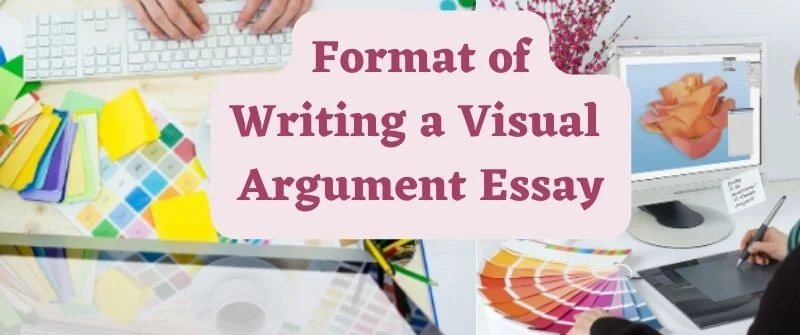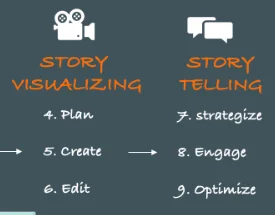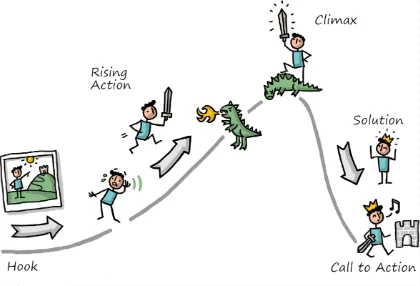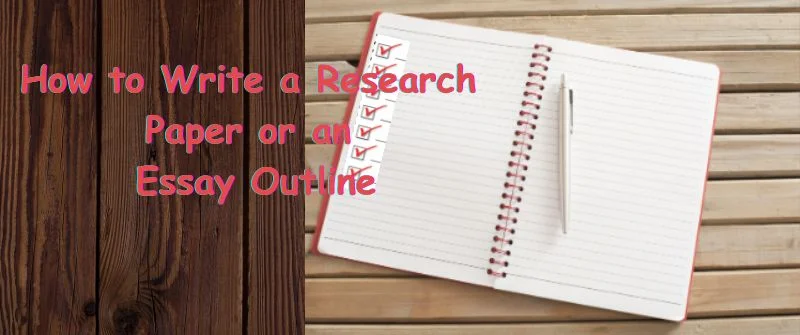How to write Visual Argument Essay: Format & Topic Examples

Have you ever found yourself in a position where you need to convey a message to your audience clearly and concisely within the shortest time possible?
The most effective way to achieve this is to create and use a visual argument.
What is a visual Argument?
A visual argument is a type of communication that utilizes images together with text to convey a persuasive perspective or message.
The visual elements of a visual argument create their case. The visual elements may include illustrations, photographs, graphs, charts, videos, infographics, videos, and other forms of visual media.
Why are Visual Arguments Important?

Visual arguments are very important, especially in contemporary media-rich work where visuals (images and videos) are prevalent in social media, advertising, and entertainment.
Thus, the ability to produce and interpret visual arguments is an important skill since visual communication should be understood by both consumers and creators of content.
Below are some reasons why visual arguments are important:
- Enhanced comprehension: Visual arguments simplify complex messages or concepts in such a way that the broader audience can understand. They distill information into digestible forms.
- Immediate impact: The use of visual elements captures the audience’s attention and conveys messages quickly. They evoke responses and make instant impression.
- Cross-cultural communication: Visual arguments can transcend cultural differences and language barriers since images and symbols are universally understood.
- Memory and retention: It is easier to remember visual information compared to text alone.
- Emotional appeal: Visuals can evoke empathy and emotions compared to words alone. When an audience has an emotional connection to your content, it makes the persuasive argument more memorable and compelling.
- Versatility: Visual arguments are applicable in diverse disciplines and contexts. They can adapt to various platforms and media, such as social, digital, and print media.
- Accessibility: Such arguments are inclusive and accessible to a diverse audience with different levels of language and literacy skills, in addition to diverse populations.
- Supporting evidence: Such arguments reinforce written or verbal arguments by giving supporting data or evidence in a more persuasive or digestible format.
- Artistic expression: Visual arguments may challenge norms, provoke thought, and provide commentary on socio-political and cultural uses when used as an art form.
Types of Visual Arguments
They include infographics, photographic arguments, advertising, political cartoons, charts and graphs, social media posts, paintings and art installations, maps and geographic visualizations, documentary films and videos, and websites and user interfaces.

They can also include medical imaging, environmental visual arguments, protest signs and banners, interactive data visualizations, public service announcements (PSAs), and architectural and urban design.
What is involved in Analyzing Visuals?
The Art of Visual Deconstruction
Here, you should begin with initial observation, whereby you look at the visual as a complete thing. What is your first emotional response or impression? Also, consider the overall color scheme, composition, and mood.
Break down the visual into its basic constituents. You identify people, objects, symbols, labels, or texts present.
Analyze the composition (placement and arrangement of elements) of the visual. Notice the use of balance, visual hierarchy, symmetry, patterns, or repetition.
Take note of color choices and contrast. Colors evoke particular associations or emotions, while contrast draws attention to specific elements.
Identifying Key Elements in Visuals
When identifying the central elements in visuals, determine the subject matter or what the visual is all about. This includes main characters, subjects, or objects central to the conveyed message.
Look for icons, symbols, and visual metaphors conveying meaning. Consider their contextual or cultural importance.
If text is present within the visual, analyze the font, placement, size, and content. Consider the text’s role in conveying the central message.
Take note of the proportions and size of elements. This can indicate importance, power dynamics, or emphasis in the visual.
Assessing Visual Rhetoric
First, consider the ethos or credibility of the source in terms of who created it and their expertise or authority on the subject.
Examine the emotional appeal (pathos) of the visual. Does it elicit emotions, feelings, or reactions?
Further, examine the logical aspect (logos) of the visual argument. Is it structured well and supported by credible evidence with statistics, data, or facts?
Consider the visual’s purpose and the intended audience. This influences the style and content of the visual.
Finally, consider the broader context in which it exists. The visual can exist within social, cultural, or historical contexts.
How to Write a Good Visual Argument Essay
1. Choose the Right Visual Argument

The first step to writing a good visual argument essay is to find the right visual for your essay. The visual should be relevant to the topic in such a way that it supports your message.
Select a relevant topic that supports what you intend to tell your audience.
Make sure that the topic speaks to the audience by helping them understand beforehand what you are going to explain.
Also, ensure that the visuals you have selected have been ethically sourced. If the visuals are not your own and you have got them from another source, make sure to cite the owners properly.
If you fail to give credit to the owners of the visuals, you are liable to face legal implications based on copyright infringement or infringement of intellectual property rights.
2. Structure your Visual Argument Essay
Select your most preferred structure for your visual argument essay. You may select the more common classic essay structure that begins with an introduction, followed by the body, and ends with a conclusion.
Make sure that you incorporate the visuals effectively. You can achieve this by matching the visuals to the message, considering the target audience since visuals resonate differently with various audiences. Maintain consistency.
Craft a strong thesis statement that summarizes your argument while allowing the audience to think more about the topic. The thesis statement should be at the end of the introduction.
3. Write Your Visual Argument Essay
When writing your visual argument essay, begin with an introduction. It should briefly provide the content and context of the essay.
Be brief and start the introduction with a statement that hooks the audience. Let it be catchy to arouse the interest of your audience.
For example, if the visual argument essay is about the dangers of cigarette smoking, the hook can be: “Did you know that smoking increases the risk of heart disease?”
In the body, make your case. This is the part in the visual argument essay where you provide all the necessary content to the audience to persuade them.
Present the evidence from the visual because visuals are supposed to give the audience a piece of evidence they can see with their eyes and even relate to. This is why visuals can evoke emotions and feelings.
Always provide context and explanation for your visuals. Let the audience understand your perspective because visual interpretation can be subjective depending on the audience’s perspectives, mood, or background.
To increase your credibility, incorporate counterarguments in your visual argument essay. It shows that you understand that there exists other perspectives and you are ready to defend your position.
End the visual argument essay with a conclusion where you wrap up your arguments by stating the main ideas, restating the thesis, and giving the implications of your work.
4. Polish up your Visual Argument Essay
Once you are done with writing the visual argument essay, polish it by proofreading and editing. This eliminates any grammatical, punctuation, and other errors to make your essay appear professional.
Since the main aim of the visual argument essay is to persuade the audience, ensure that the content is clear and coherent. Reread the essay and imagine yourself as the audience. Would you instantly understand it? If not, revise the work.
Further, because the argument essay relies more on visuals, make sure that it is visually appealing. Analyze the visuals well to ensure that all the elements fit into a singular composition.
5. Cite and Sources and Giving Credit
Finally, ensure that you properly cite the visual sources that are not your property. Give the owners credit for their work through in-text citations and complete references.
Avoid plagiarizing the visual argument essay. Ensure that you come up with unique content to avoid facing plagiarism penalties if the work is assessed by a professional body.
Tips to Write a Successful Visual Essay
Building a Strong Argument

To write a successful visual essay, build a strong argument that is compelling and interesting to the target audience.
Make sure that the content is unique because the audience will be bored reading or listening to something they have already encountered before.
The argument should be worthwhile to the audience. Let it appeal to their ethos, logos, and pathos.
Engaging Your Audience Visually
Ensure that the audience is engaged visually throughout the visual argument essay. Visuals enhance the perceptions, memory retention capacity, and emotions of the audience. Thus, use visuals effectively to engage your audience for maximum persuasion.
Final Thoughts on Writing a Visual Argument Essay
Visual argument essays are meant to persuade an audience. Therefore, the use of visuals in combination with text can enhance audience engagement.
While using visuals, use them effectively to maximize audience engagement and make them aesthetically appealing. Also, use them ethically by crediting their source.
Conclusion
A visual argument essay is a subset of persuasion and rhetoric where the author or presenter uses written and verbal arguments in combination with visual elements to enhance their case.
It is the most effective way of persuading your audience to resonate with your point of view or arguments.

Josh Jasen or JJ as we fondly call him, is a senior academic editor at Grade Bees in charge of the writing department. When not managing complex essays and academic writing tasks, Josh is busy advising students on how to pass assignments. In his spare time, he loves playing football or walking with his dog around the park.




